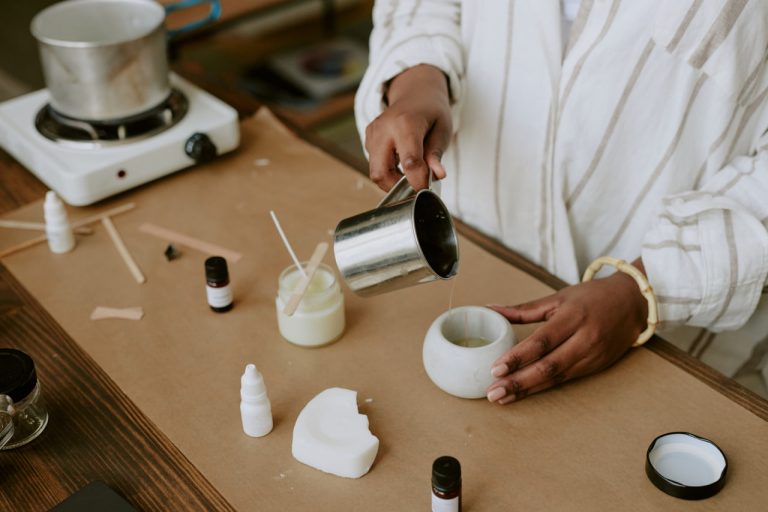The Science Behind Candle Making: Understanding Wax Types and Their Properties
Introduction to Candle Wax Candle making is both an art and a science. While creativity…
Introduction to Candle Wax
Candle making is both an art and a science. While creativity plays a vital role in designing beautiful candles, understanding the materials—especially the wax—is essential to producing high-quality, safe, and long-lasting products. Wax is the foundation of any candle, affecting everything from how the candle burns to how it holds fragrance and color. This article explores the different types of wax used in candle making and explains their unique properties to help you make informed choices for your craft.
Common Types of Candle Wax
Paraffin Wax
Paraffin wax is the most commonly used wax in candle making, favored for its versatility and affordability. It is a petroleum byproduct, derived from refining crude oil. Paraffin wax burns cleanly, has excellent scent throw (how well it releases fragrance), and is easy to color and mold. However, because it is petroleum-based, some candle makers and consumers seek alternatives that are more sustainable or natural.
Soy Wax
Soy wax is a popular natural alternative made from soybean oil. It burns slower and cooler than paraffin, resulting in longer-lasting candles. Soy wax has a creamy appearance and holds fragrance well, making it ideal for scented candles. Additionally, soy is biodegradable and renewable, aligning with eco-friendly preferences. However, soy wax can be softer and sometimes requires additives to achieve the desired hardness or melting point.
Beeswax
Beeswax is a natural wax produced by honeybees. It is prized for its natural scent, warm glow, and clean-burning properties. Beeswax candles emit negative ions when burned, which can purify the air by reducing dust and allergens. Due to its natural origin, beeswax is often more expensive and harder to work with than other waxes. It has a higher melting point, which can affect pouring and curing times.
Palm Wax
Derived from palm oil, palm wax creates candles with distinctive crystalline or feathered patterns on the surface. It is harder and more brittle than soy or paraffin, offering excellent mold release and a unique texture. However, sustainability concerns surround palm oil production, so it’s important to source palm wax from certified sustainable suppliers.
Gel Wax
Gel wax is a translucent, rubbery material made from mineral oil and polymer resin. It is used primarily for decorative candles where a clear, glass-like appearance is desired. Gel wax holds fragrance well and can suspend objects such as shells or glitter within the candle. Because of its chemical composition, gel wax requires special handling and additives for safe burning.
Key Properties to Consider
Melting Point
The melting point determines how quickly a candle melts and burns. A higher melting point wax like beeswax or palm wax burns more slowly and retains shape better in warm environments. Lower melting point waxes like soy or paraffin melt faster and can drip more. Matching the melting point to your candle type and use environment is essential for optimal performance.
Scent Throw
Scent throw is divided into cold throw (the fragrance released when the candle is unlit) and hot throw (the fragrance released when the candle is burning). Paraffin and soy waxes generally have excellent scent throws, making them popular for scented candles. Beeswax has a natural honey scent that may overpower added fragrances, while gel wax holds scents very well but requires specific fragrance oils compatible with its chemistry.
Burn Time and Cleanliness
Different waxes burn at different rates. Soy and beeswax typically burn longer and cleaner than paraffin, which can produce more soot and toxins. Clean-burning waxes are especially important for indoor air quality and customer satisfaction.
Appearance and Texture
Wax appearance can vary widely, from the creamy opacity of soy wax to the glossy translucence of gel wax. Beeswax often has a warm golden hue, while paraffin is usually white or clear before adding dyes. The texture affects the candle’s finish and the types of molds or containers suitable for use.
Blended Waxes: Combining Benefits
Many candle makers use blended waxes to combine the best properties of different waxes. For example, soy-paraffin blends improve scent throw and hardness, while adding beeswax can enhance burn quality and natural appeal. Understanding how waxes interact helps you customize candles for specific purposes.
Choosing the Right Wax for Your Project
Selecting the perfect wax depends on your goals, whether it’s crafting long-lasting scented candles, decorative gel candles, or eco-friendly natural options. Consider factors such as the desired burn time, fragrance intensity, environmental impact, and cost. Experimentation is key—testing different waxes and blends can reveal what works best for your style and market.




